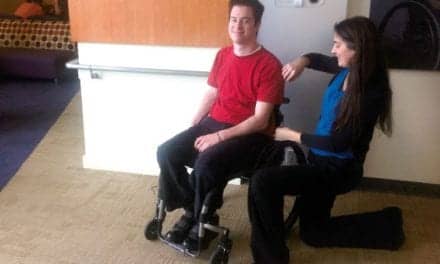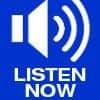Goals to advance specialized programs and education reinforce successful functional measurement and assessment in stroke patients.
by Erin Donnelly, PT, NCS, and Marisa King, PT, DPT
It is estimated that there are 795,000 individuals who suffer from a stroke in the United States annually (Centers for Disease Control and Prevention, 2013). It appears that advances in medicine have resulted in improvements in survival rates post stroke, making the rehabilitation and education process even more imperative in this population. The physical therapists at Kessler Institute for Rehabilitation, an acute inpatient rehabilitation facility in New Jersey, have found that patients have a more successful return to home and improved quality of life as a result of early therapeutic interventions. The institute, which is CARF accredited in several areas, including stroke, uses an interdisciplinary approach, and each patient is treated in a manner that provides consistent, yet individualized care. The attending physician monitors each patient’s medical condition and manages their overall care. Other members of the inpatient team include the case manager, nurse, physical therapist, occupational therapist, speech language pathologist, recreational therapist, pharmacist, dietician, nutritionist, respiratory therapist, and psychologist. Each member, as appropriate, evaluates the patient on admission and creates a plan of care that is reassessed on a weekly basis as a team.
Emphasis on a multidisciplinary approach enables therapists to work as a team toward individualized patient goals with the aim of fostering successful outcomes. A range of therapy services is provided, including traditional interventions, group programs, therapeutic technologies, and patient and family classes. Kessler also emphasizes the use of standardized measures to determine the effectiveness of interventions, capture improvements in functional outcomes, and ensure that our patients are exceeding the expectations set by national benchmarks. A Stroke Rehab Coordinator is part of the staff and assists with bridging the gap between inpatient facilities and a research partner, the Kessler Foundation. This relationship helps stakeholders remain current with stroke research, and also allows therapists and patients to be actively involved in shaping the future of stroke rehabilitation through research.
The primary focus of physical therapists at Kessler is promoting increased independence for patients in the area of functional mobility—whether at an ambulatory or wheelchair level—so patients may safely return home. Patients receive traditional physical therapy services including strengthening and balance tasks, transfer training, ambulation and elevations training, wheelchair management and propulsion skills, fall recovery training, and activities focusing on cardiovascular endurance. To assist in targeting these areas, Kessler’s traditional services are supplemented with the latest advances in technology.
Treatment Technologies
Functional electrical stimulation (FES) is a technology the facility utilizes regularly for post stroke patients and is also offered as a specialty program. While there are multiple means to provide FES to patients post stroke, a wearable wireless FES system is frequently used at Kessler. These systems are used in conjunction with traditional interventions to promote increased or improved muscle activation and improved motor sequencing, particularly during ambulation and stair negotiation. Additionally, this type of system is used on the lower extremity to provide increased sensory feedback and promote improved awareness of the limb. Standard FES and TENS units also can be used as appropriate on patients participating in the stroke program.
Another technology and specialty program that is available for patients in the stroke program is the body weight support system (BWSS). The BWSS can be utilized both over ground and over a treadmill to provide patients with a safe environment and allow physical therapists more freedom to use their hands for targeted manual facilitation during ambulation and pregait activities. The BWSS also allows therapists to control the degree to which the patient is unweighted to achieve the most normal gait pattern possible. Additionally, the use of the BWSS not only allows therapists to safely initiate ambulation for patients requiring a greater degree of physical assistance, but it also allows longer trials of ambulation to be safely performed, resulting in increased mass repetition and promotion of neuroplasticity. When appropriate, the BWSS can be used in conjunction with other technologies such as an FES system.
Protocol and Gains
Patients at all levels of involvement and stages of recovery are accepted into the stroke program. Staff is well trained to treat all impairments, and appropriate technologies are available for each patient level. For patients who have been in the acute care hospital for prolonged periods of time or who as a result of their medical comorbidities present with poor tolerance to being upright, therapists have the ability to gradually reintroduce them to an upright posture with the use of tilt tables or support them in a full upright standing position with a standing frame. While the patient is supported in these positions, the physical therapists will engage them in additional therapeutic tasks. Added benefits of the tilt table or standing frame in the stroke population include increased arousal, prolonged lower extremity weight bearing, increased proprioceptive feedback, reduction of hypertonicity, prolonged stretching, reorientation to midline alignment, pulmonary health, skin care and improved circulation, and gastrointestinal health.
As physical therapists in an acute rehab setting, it is important to demonstrate the functional and quality of life gains that patients are making. To assist us in capturing these gains, Kessler encourages therapists to regularly use appropriate standardized objective measures. Within the stroke program, there are several measures used regularly by the facility’s physical therapists, some of which are required. The Functional Independent Measure (FIM) is used on all patients admitted to Kessler at admission and discharge and is scored by physical therapy, occupational therapy, and nursing. The BERG Balance Scale, Timed Up and Go, and Dynamic Gait Index are the three most common outcomes measures used to assess a patient’s risk for falling and to track improvements in balance. These measures also assist physical therapists in determining whether a patient is safe to progress to an independent or modified independent level. Another measurement tool used in the stroke population is the 6-Minute Walk Test or 2-Minute Walk Test to demonstrate gains in endurance for higher functioning patients. The 10-Meter Walk Test is an objective measure frequently used to assess gait speed and support gains toward becoming a functional community ambulator and achieving an improved quality of life. A patient’s perception of their own health and level of function is vital, and either the PT or the OT will administer the Euro-QOL, as appropriate, to stroke patients on admission and discharge. This measure provides the therapist with insight into a patient’s perception of overall health gains and whether they are able to accurately assess their health status.
There are also clinics available on-site for patients in the stroke program. The inpatient brace clinic includes a physician and physical therapist who work in collaboration with a certified orthotist. The orthotist is present to consult with patients who select them as a provider. At each of these clinics, the team assesses the patient and recommendations are made to the patient’s primary therapist and physiatrist. There is also a wheelchair clinic for those patients who will require the use of a custom wheelchair upon discharge. During this clinic, the Assistive Technology Professional (ATP) performs a thorough seating assessment. This includes the use of a pressure mapping system to provide visual feedback to both the clinician and the patient. This information is used to prescribe the most appropriate pressure relieving cushion for the patient and also demonstrates the importance of weight shifting to the patient. Furthermore, whether through a formal clinic or via an assessment by primary physician and therapist, the facility’s stroke patients have the opportunity to address their spasticity. This may result in medical interventions by the physician or interventions by therapy including serial casting.
It is imperative for PTs to work closely with the other members of the rehab team in the acute rehabilitation setting. The occupational and physical therapists treat in the same space and work closely with each patient case. When developing the plan of care for patients status post stroke, the occupational therapist will often focus treatment on maximizing the patient’s function in regard to their performance with activities of daily living, cognitive abilities, and any visual impairments that may be a result of their stroke. The institute’s occupational therapists utilize evidence-based practice and technology to develop the most appropriate treatment plans for patients. The occupational therapists utilize standardized outcome measures to track the outcomes of their patients. Some of these measures include the Motor Assessment Scale, the WOLF, the Kessler Foundation Neglect Assessment Process (KFNAP), the Chedoke Arm and Hand Inventory, the Orientation Log (O-LOG), and the Montreal Cognitive Assessment just to name a few. In addition, the occupational therapists have access to technologies such as upper extremity FES units. In addition to these technologies, occupational therapists will use their clinical experience and expertise to ensure patients receive optimal care. The physical and occupational therapists work closely together to build upon one another’s treatment sessions and ensure a collaborative process in reaching each patient’s individual goals.
The majority of patients in the stroke program also receive speech therapy services. The speech therapist may focus on patients’ cognitive impairments, language impairments (eg, aphasia), speech impairments (eg, dysarthria, apraxia), swallowing impairments (eg, dysphagia), or other issues that affect a patient’s social interaction. The speech therapists also base their assessments and interventions on evidence-based practice and have access to technology to enhance their outcomes. Neuromuscular Electrical Stimulation (NMES) is utilized by speech therapists on patients with dysphagia to assist in improving their ability to swallow. It is extremely important that the physical and occupational therapists are well aware of the speech interventions that each patient is receiving so that they can incorporate the strategies into their treatment session in order to optimize the patient’s outcomes.
The nursing staff, including the nurse and nursing aides, are also an imperative part of the rehabilitation team. Maintaining good communication with the nurse is extremely important to ensure that the therapists are treating each patient in a holistic manner. There are often formal and informal conversations between the therapy team and the nursing staff in regard to the patient’s tolerance to therapy, medication reactions, or other changes in status. In addition, the therapists communicate closely with the nursing aides, realizing that they spend a significant amount of time with each patient compared to the other members of the team. The therapists ensure that the aides are comfortable with performing appropriate transfers with each patient and following through with interventions or strategies that are performed during therapy.
Training and Education
The importance of patient and family education for those served in the stroke program is understood among staff members. Hands-on family training is initiated by all therapies and nursing staff as soon as it is safe and appropriate to do so. In addition to ongoing daily education that is provided, there are several more formalized means to provide education and support to patients and their caregivers. Upon admission, each patient in the stroke program is provided with a hard copy of the institute’s Patient and Family Guide to Stroke Recovery. An educational presentation and handout called Steps to Wellness have also been developed, and are offered to patients and caregivers several times a month. Steps to Wellness is run by the therapy department, and while the presentation provides the structure, the group is a forum for patients and caregivers to ask questions and meet other individuals going through a similar experience. Some of the topics addressed in the guide and presentation include signs and symptoms of a stroke, common impairments following a stroke, the rehabilitation team and process, what to expect while a patient at the facility, discharge planning, stroke prevention, support services, and research opportunities. The facility also hosts monthly stroke support groups run by a neuropsychologist or psychologist, and open to patients, caregivers, and the public.
Formal team conferences are held weekly with all members of the team present to ensure that the family and each member of the team are aware of the patient’s program and discharge plan. In addition to this, there are unique programs that emphasize the importance of a team approach to rehab. One of these programs is Behavior Rounds in which members of the team meet to discuss patients who have behavioral issues that are limiting their progress in therapy. During these meetings, a behavioral plan is developed with input from all members of the team including nursing aides. Another program that was developed for neurologically impaired patients, including those in the stroke program, is the Therapeutic Observation Program (TOP). Rehabilitation/nursing aides are specifically trained by members of the therapy team to work in this program. Patients who present with restlessness or are a safety risk if left alone in their room attend this program. It provides a social and safe environment for patients. Another interdisciplinary program is Medication Management, which includes the pharmacist, an occupational therapist, and a nurse. Patients and their caregivers participate in this program as a way to help prepare them to manage their medications appropriately when discharged.
Staff members at this facility realize that the transition back to home is often a stressful and uneasy time for patients and their caregivers. To assist in making this process safe, fluid, and less stressful, therapists can have patients participate in therapeutic community outings to simulate activities they will have to perform upon discharge. The use of community outings helps the patient to gain improved insight into their strengths and limitations in the community setting and allows the therapy team to make more realistic and accurate discharge recommendations. When there are unanswered questions regarding home access and setup that cannot be adequately answered with a standard home assessment form, therapists can perform home evaluations. The home evaluation allows the therapy team to assess any potential barriers to mobility or safety issues within the home and problem solve the environment and/or make detailed recommendations for home modifications.
Physical therapists in this acute rehabilitation setting have found each patient’s success relies on the entire interdisciplinary team working with patients and each other to achieve that individual patient’s goals. Kessler Institute for Rehabilitation, ranked second among rehabilitation hospitals in the nation by U.S. News & World Report, provides extensive services to individuals post stroke across the many stages of recovery. The facility strives to continue to develop its programs and staff skills through education and research, ensuring patients continue to receive optimal care. RM
Erin Donnelly, PT, NCS, received her master’s degree in physical therapy from Northeastern University. She has worked at Kessler Institute for Rehabilitation since 2004, focusing her career on those patients with neurological diagnoses, specifically traumatic brain injury and stroke. Donnelly received her Neurological Certified Specialist certification through the APTA. She is currently the physical therapy clinical manager at the Saddle Brook site and one of the program coordinators and mentors for Kessler’s Residency in Neurological Physical Therapy.
Marisa King, PT, DPT, earned her degrees from Ithaca College and has been working at Kessler Institute for Rehabilitation for the past 7 years. She has specialized in stroke and brain injury rehabilitation and is currently a clinical manager at the West Orange campus. For more information, contact [email protected].





